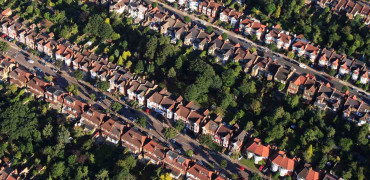Did you know that around 80% of the buildings we will use when we get to 2050 are already here?
In other words, millions of homes, offices, schools, and other buildings have already been built over the last years, decades, centuries.
And, even ignoring the historic value of these buildings, we couldn’t simply knock them all down and replace them with new build, even if we wanted to.
So, one of the major things we need to tackle as we look to reach the net zero target for carbon emissions, are these existing buildings, many of them shockingly inefficient in terms of energy performance.
Mass insulation has to take place alongside an acceleration in the installation of renewables
It didn’t have to be this way
Britain has suffered from some very bad building practices over the years, but we also have homes that were well designed for a different time and a different way of living.
Whilst they may have suited say the Victorians and their coal-based technologies, now they struggle to match the need for energy efficiency we demand from modern homes.
I read an interesting piece in the Guardian recently about ‘Energy efficiency guru’ Amory Lovins whose 1980’s house doesn’t have any heating despite being high in the Colorado mountains where temperatures can drop far below freezing.
The home is so well designed and so well insulated that Lovins grows tropical fruits there without needing to use gas, oil or wood, proving that good design can lead to a brilliant place to live while also seriously helping to reduce carbon emissions.
The time is right for energy efficiency
According to the article, Lovins is nicknamed the “Einstein of energy efficiency” and has been one of the world’s leading advocates and innovators of energy conservation for more than 50 years.
Energy efficiency has been seen as extremely dull compared to the ‘exciting’ world of renewable technologies, but Lovins argues that the mass insulation of buildings has to take place alongside an acceleration in the installation of renewables.
As someone who lives in a house built in 1910 with solid brick walls and single-pane, sash windows, I couldn’t agree more. I know I need to improve the energy efficiency of my home, especially as my monthly energy bill has just shot up by over 100%, but in reality I’m going to struggle to fund new windows, better insulation and possibly even a new roof!
And I also know that I’m not alone.
I must add that we can’t expect the taxpayer to fund all of the improvements needed on homes like mine but like millions of other properties, something has to be done if we are to get anywhere near to our carbon reduction targets.
And when you read headlines claiming that we are all paying more for our energy due to cuts in green subsidies, it makes it difficult to see quite how we are going to get anywhere near net zero.
I need a tea cosy for my home
And that’s where the first article offers a ray of hope.
In addition to the mass retrofitting of insulation and the installation of heat pumps, Lovins calls for what he terms “outsolation”, or what could be described as ‘putting a sort of tea cosy around houses’.
This is already being offered by the Dutch company Energiesprong and their exterior retrofit.
They claim to be able to superinsulate your house complete to net zero standard in just one day.
Creative ways of funding
So solutions are available or coming and the issue seems to be one of funding. So just how can we encourage people to invest for the future when energy bills are eating up any disposable income?
The Chancellors latest Spring statement for example did cut VAT on renewable technologies such as heat pumps, but for many, there is little point in looking at renewables until the efficiency of the whole property has been tackled.
And how can government be encouraged to do more to support people desperate to be more energy efficient when there are too many obstacles to buying energy efficiency?
As Lovins states in the article, we need new ways of creative thinking.
Perhaps we should be paying designers, architects and engineers for the energy savings they build into properties.
Perhaps energy companies should be penalised for selling more energy and rewarded for cutting energy use?
And perhaps the whole tax system can be used to increase the uptake of renewables and fund long-term investment programmes that would help homes like mine, without overburdening the state?
Who knows, just a little bit of creative thinking could take us a long way down the road to net zero!
Russell Jones is content and communications manager




